HONDA PRELUDE 1992 User Guide
Manufacturer: HONDA, Model Year: 1992, Model line: PRELUDE, Model: HONDA PRELUDE 1992Pages: 225, PDF Size: 2.1 MB
Page 11 of 225
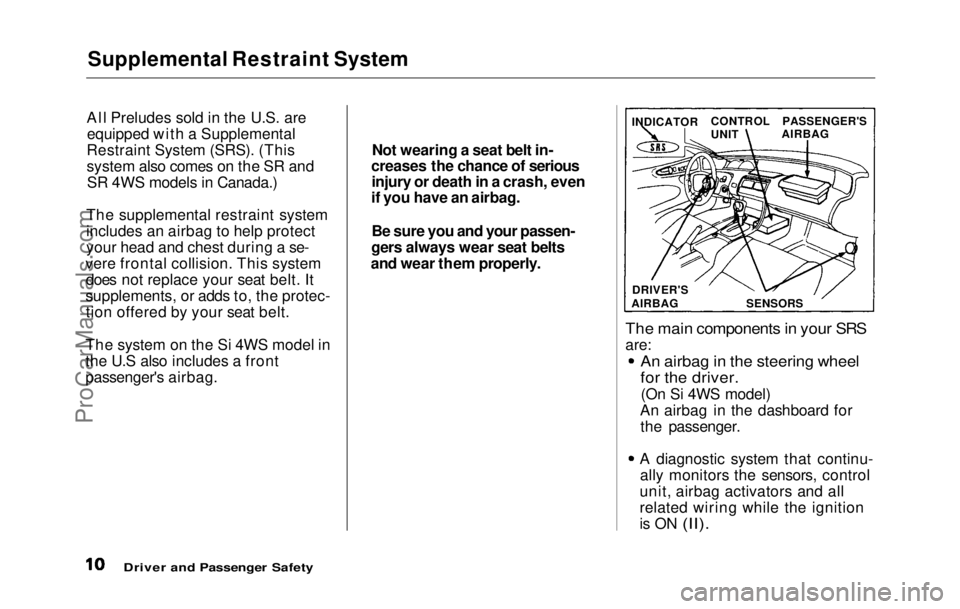
Supplemental Restraint System
All Preludes sold in the U.S. are equipped with a Supplemental
Restraint System (SRS). (This
system also comes on the SR and SR 4WS models in Canada.)
The supplemental restraint system
includes an airbag to help protect
your head and chest during a se-
vere frontal collision. This system does not replace your seat belt. It
supplements, or adds to, the protec- tion offered by your seat belt.
The system on the Si 4WS model in
the U.S also includes a front
passenger's airbag.
The main components in your SRS
are:
An airbag in the steering wheel
for the driver.
(On Si 4WS model)
An airbag in the dashboard for the passenger.
A diagnostic system that continu- ally monitors the sensors, control
unit, airbag activators and all
related wiring while the ignition
is ON
(II).
Driver and Passenger Safety
Not wearing a seat belt in-
creases the chance of serious injury or death in a crash, even
if you have an airbag.
Be sure you and your passen-
gers always wear seat belts
and wear them properly. INDICATOR
CONTROL
UNITPASSENGER'S
AIRBAG
DRIVER'S
AIRBAG
SENSORSProCarManuals.comMain Menu Table of Contents s t
Page 12 of 225
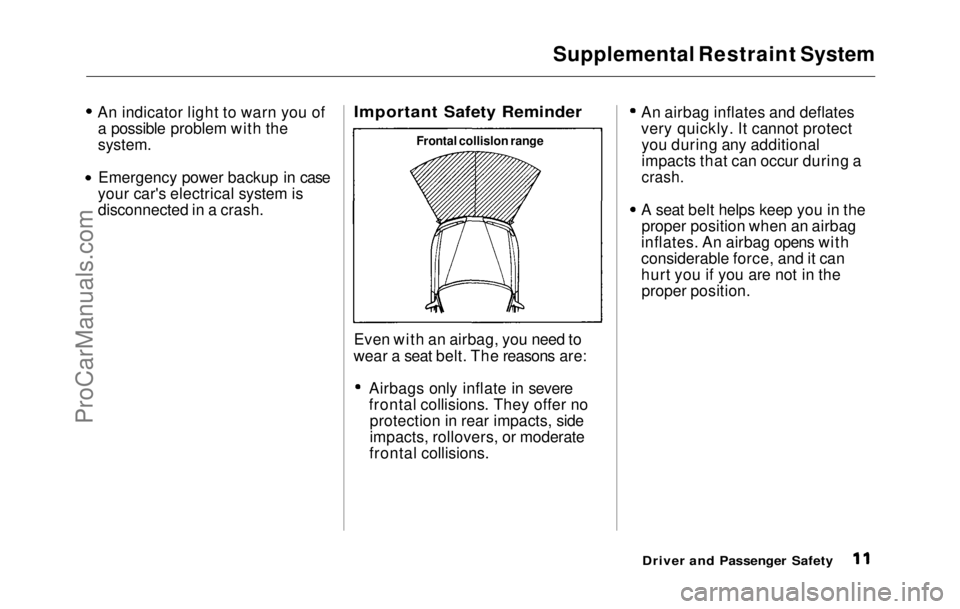
Supplemental Restraint System
An indicator light to warn you of a possible problem with the
system.
Emergency power backup in case
your car's electrical system is
disconnected in a crash.
Important Safety Reminder
Even with an airbag, you need to
wear a seat belt. The reasons are: Airbags only inflate in severe
frontal collisions. They offer no
protection in rear impacts, side
impacts, rollovers, or moderate
frontal collisions. An airbag inflates and deflates
very quickly. It cannot protect
you during any additional
impacts that can occur during a
crash.
A seat belt helps keep you in the
proper position when an airbag
inflates. An airbag opens with
considerable force, and it can
hurt you if you are not in the proper position.
Driver and Passenger Safety
Frontal collislon rangeProCarManuals.comMain Menu Table of Contents s t
Page 13 of 225
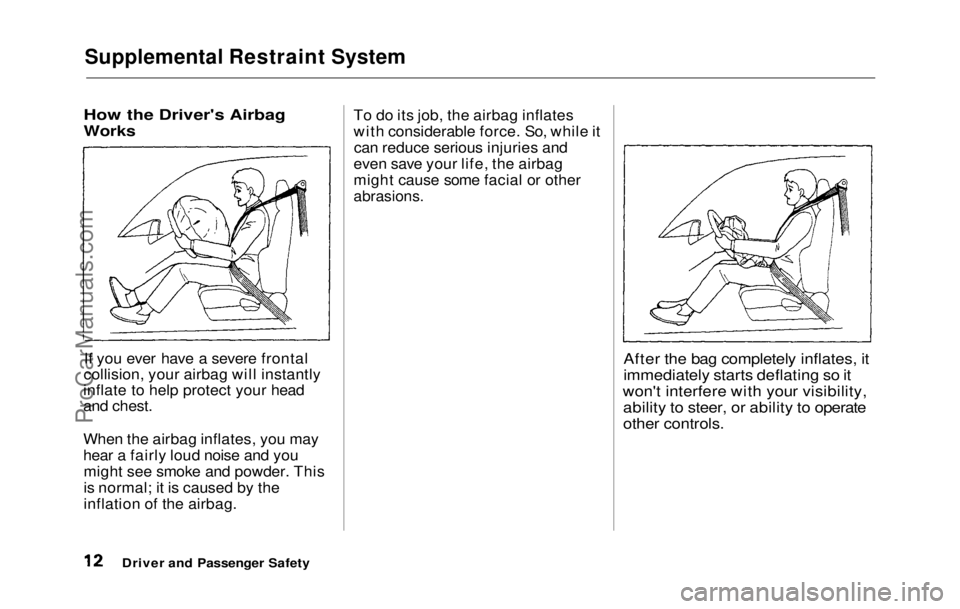
Supplemental Restraint System
How the Driver's Airbag
Works
If yo
u ever have a severe frontal
collision, your airbag will instantly
inflate to help protect your head
and chest.
When the airbag inflates, you may
hear a fairly loud noise and you
might see smoke and powder. This
is normal; it is caused by the
inflation of the airbag. To do its job, the airbag inflates
with considerable force. So, while it
can reduce serious injuries and
even save your life, the airbag
might cause some facial or other
abrasions.
After the bag completely inflates, it
immediately starts deflating so it
won't interfere with your visibility,
ability to steer, or ability to operate
other controls.
Driver and Passenger SafetyProCarManuals.comMain Menu Table of Contents s t
Page 14 of 225
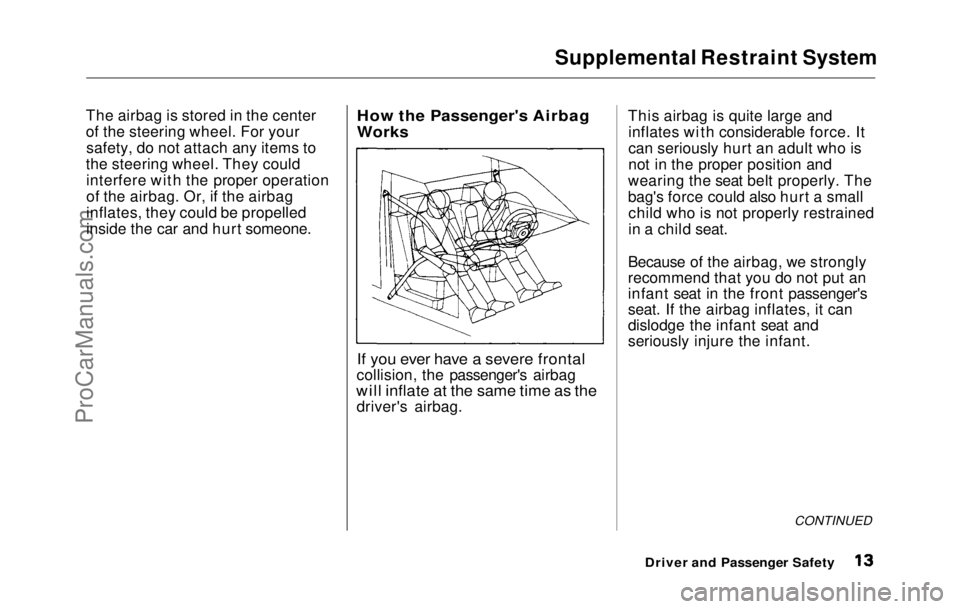
Supplemental Restraint System
The airbag is stored in the center
of the steering wheel. For your safety, do not attach any items to
the steering wheel. They could interfere with the proper operation
of the airbag. Or, if the airbag
inflates, they could be propelled
inside the car and hurt someone.
How the Passenger's Airbag
Works
If you ever have a severe frontal
collision, the passenger's airbag
will inflate at the same time as the
driver's airbag. This airbag is quite large and
inflates with considerable force. It
can seriously hurt an adult who is
not in the proper position and
wearing the seat belt properly. The
bag's force could also hurt a small child who is not properly restrained
in a child seat.
Because of the airbag, we strongly
recommend that you do not put an
infant seat in the front passenger's
seat. If the airbag inflates, it can
dislodge the infant seat and
seriously injure the infant.
CONTINUED
Driver and Passenger SafetyProCarManuals.comMain Menu Table of Contents s t
Page 15 of 225
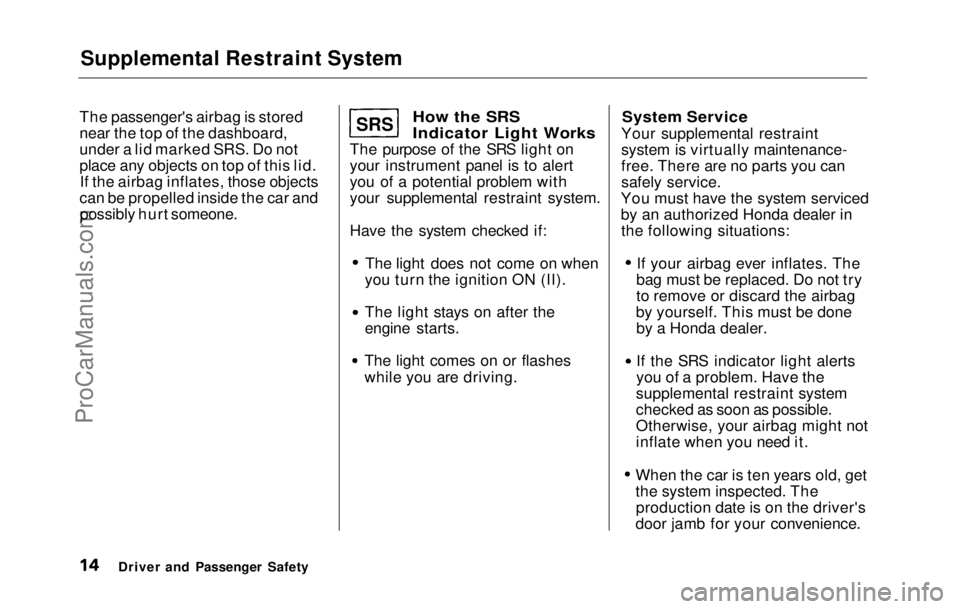
Supplemental Restraint System
The passenger's airbag is stored
near the top of the dashboard,
under a lid marked SRS. Do not
place any objects on top of this lid. If the airbag inflates, those objects
can be propelled inside the car and possibly hurt someone.
How the SRS
Indicator Light Works
The purpose of the SRS light on
your instrument panel is to alert
you of a potential problem with
your supplemental restraint system.
Have the system checked if:
The light does not come on when
you turn the ignition ON (II). The light stays on after the
engine starts.
The light comes on or flashes
while you are driving.
System Service
Your supplemental restraint
system is virtually maintenance-
free. There are no parts you can
safely service.
You must have the system serviced
by an authorized Honda dealer in the following situations: If your airbag ever inflates. The
bag must be replaced. Do not try
to remove or discard the airbag
by yourself. This must be done by a Honda dealer.
If the SRS indicator light alerts
you of a problem. Have the
supplemental restraint system
checked as soon as possible.
Otherwise, your airbag might not
inflate when you need it. When the car is ten years old, get
the system inspected. The
production date is on the driver's
door jamb for your convenience.
Driver and Passenger Safety
SRS
ProCarManuals.comMain Menu Table of Contents s t
Page 16 of 225

Supplemental Restraint System
System Service Precautions
Do not modify your steering wheel
or any other part of the supple-
mental restraint system. Modifica-
tions could make the system inef-
fective.
Do not tamper with the system
components or wiring. This could cause the airbag to inflate inadver-
tently, possibly injuring someone
very seriously.
Tell anyone who works on your car
that you have a supplemental
restraint system. Failure to follow
the procedures and precautions in
the official Honda service manualcould result in personal injury or
damage to the system.
Scrapping an entire car that has an
uninflated airbag can be dangerous.
Get assistance from a Honda dealer
if your car must be scrapped.
If you sell your car, please be sure
to tell the new owner that the car
has a supplemental restraint sys-
tem. Alert them to the information
and precautions in this part of the
owner's manual.
Driver and Passenger SafetyProCarManuals.comMain Menu Table of Contents s t
Page 17 of 225
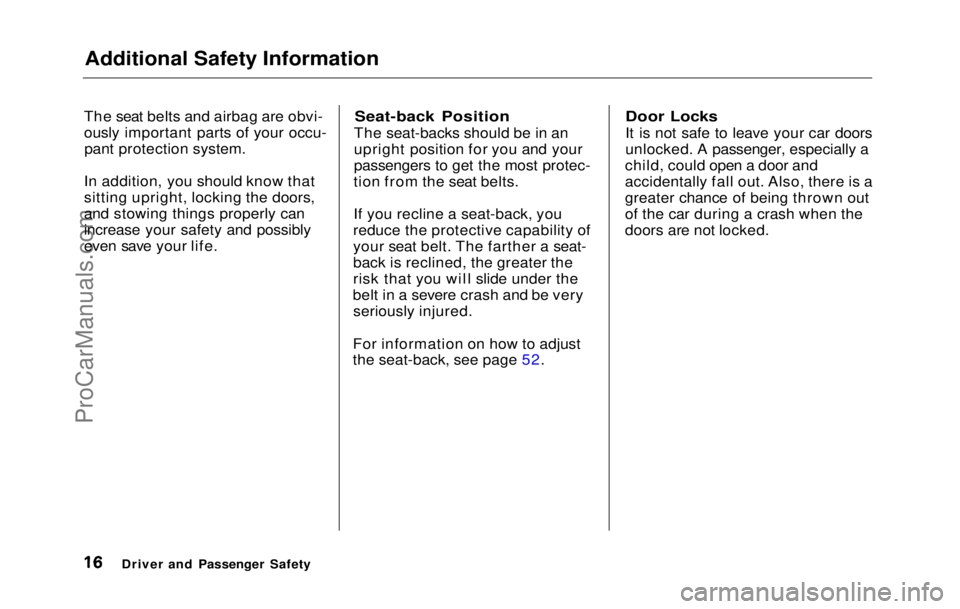
Additional Safety Information
The seat belts and airbag are obvi-
ously important parts of your occu- pant protection system.
In addition, you should know that
sitting upright, locking the doors,
and stowing things properly can
increase your safety and possibly
even save your life.
Seat-back Position
The seat-backs should be in an
upright position for you and your
passengers to get the most protec-
tion from the seat belts.
If you recline a seat-back, you
reduce the protective capability of
your seat belt. The farther a seat-
back is reclined, the greater the
risk that you will slide under the
belt in a severe crash and be very seriously injured.
For information on how to adjust
the seat-back, see page 52.
Door Locks
It is not safe to leave your car doors
unlocked. A passenger, especially a
child, could open a door and
accidentally fall out. Also, there is a
greater chance of being thrown out
of the car during a crash when the
doors are not locked.
Driver and Passenger SafetyProCarManuals.comMain Menu Table of Contents s t
Page 18 of 225

Additional Safety Information
Storing Cargo Safely
Before you drive, make sure you
first securely store or tie down any items that could be thrown around
the car and hurt someone, or interfere with your ability to
operate the controls.
Do not put any items on top of the
rear shelf. They can block your
view and they could be thrown about the car in a crash.
Be sure to keep compartment doors
closed when the car is moving. If a
front passenger hits the door of an open glove box, for example, he
could injure his knees.
Driving with Pets
Loose pets can be a hazard while
you are driving. A loose pet can
interfere with your ability to drive
the car. In a crash or sudden stop,
loose pets or cages can be thrown
around inside the car and hurt you
or your passengers. It is also for
their safety that pets should be properly restrained in your car.
The recommended way to restrain
a medium-sized or larger dog is
with a special traveling harness.
This harness can be secured to the
rear seat with a seat belt. Travel
harnesses are available at pet
stores.
A small dog, cat, or other small
animal will be safest in a rigidly-
sided pet carrier. Choose a style
that allows you to secure it to the
car's seat by routing a seat belt
through the carrier's handle.
For further information, contact
your veterinarian or local animal
protection society.
Driver and Passenger SafetyProCarManuals.comMain Menu Table of Contents s t
Page 19 of 225
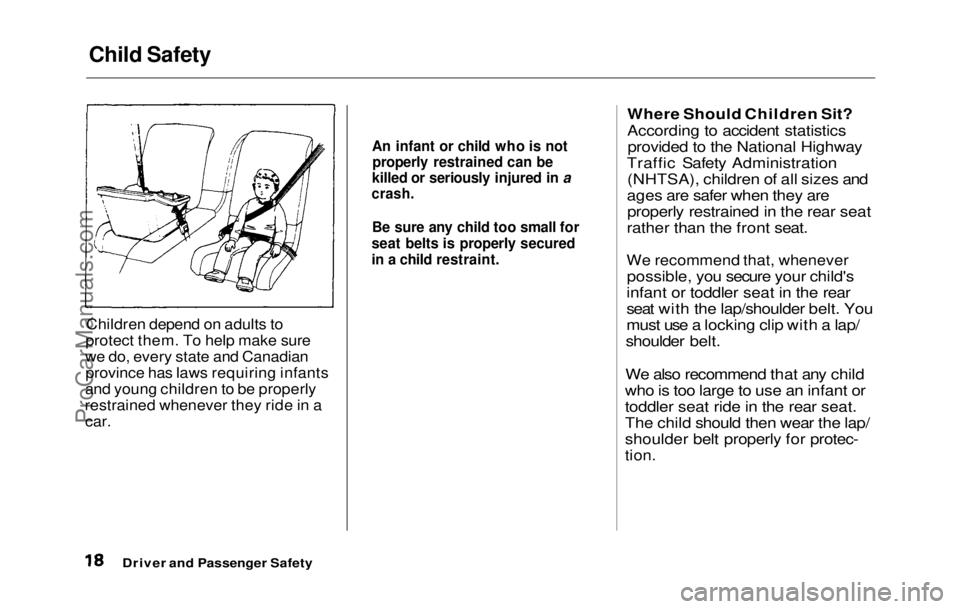
Child Safety
Children depend on adults to
protect them. To help make sure
we do, every state and Canadian province has laws requiring infants
and young children to be properly
restrained whenever they ride in a car.
Where Should Children Sit?
According to accident statistics
provided to the National Highway
Traffic Safety Administration (NHTSA), children of all sizes and
ages are safer when they are properly restrained in the rear seat
rather than the front seat.We recommend that, whenever
possible, you secur
e your child's
infant or toddler seat in the rear
seat with the lap/shoulder belt. You
must use a locking clip with a lap/
shoulder belt.
We also recommend that any child
who is too large to use an infant or
toddler seat ride in the rear seat.
The child should then wear the lap/
shoulder belt properly for protec-
tion.
Driver and Passenger Safety
An infant or child who is not
properly restrained can be
killed or seriously injured in a
crash.
Be sure any child too small for
seat belts is properly secured
in a child restraint.ProCarManuals.comMain Menu Table of Contents s t
Page 20 of 225

Child Safety
Important Safety Reminders
Never hold
a baby or child on your
lap when riding in a car. If you are
wearing your seat belt, the violent
forces created during a crash will
tear the child from your arms. The
child could be seriously hurt or
killed.
If you are holding a child and not
wearing a seat belt in a crash, you could crush the child against the
car's interior.
Never put your seat belt over
yourself an d
a child. During a crash,
the belt could press deep into the
child; causin
g
serious internal
injuries.
Two children should never use the same seat belt. If they do, they
could be very seriously injured in a
crash.
General Guidelines for
Restraining Children Under
18 kg (40 Ibs)
Use an approved child seat. The
seat must meet Federal Motor
Vehicle Safety Standard 213 (FMVSS-213) or Canadian Motor
Vehicle Safety Standards. Look for
the manufacturer's statement of compliance on the box and seat.
Use a seat of the right size. Make
sure the seat fits your child. Check
the seat manufacturer's instruc-
tions and labels for height and
weight limits.
Secure the child seat to the car. All
approved child seats are designed
to be secured in the car seat by the
lap belt or the lap belt portion of a
lap/shoulder belt. A child whose
seat is not properly secured to the
car can be endangered in a crash.
To properl y
route a seat belt
through a child seat, follow the seat
maker's instructions. Be sure you
install a locking clip on a lap/
shoulder belt (see page 22).
Secure the child in the child seat.
Make sure the infant or child is
firmly secured to the child seat.
Use the straps provided, and
carefully follow the manufacturer's
instructions.
Driver an d
Passenger SafetyProCarManuals.comMain Menu Table of Contents s t